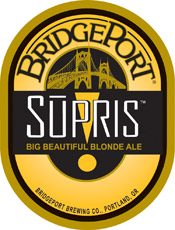More new beers or returning seasonals:
Verdi Verdi Good from Dogfish Head in Delaware. Just in time for St. Patrick’s Day – A Dortmunder greened with Spirulina. The website explains:
The idea for the the Dogfish Head version actually was born of beers already being produced in Southeast Asia, namely Myanmar (formerly Burma) and Thailand. The main type of beer made in that area of the world is akin to the Dortmunder/Export type lagers of Germany. Both Myanmar and Thailand have breweries producing a beer which is their regular production lager with spirulina added. Hence, Verdi Verdi Good was born.
 Saint Arnold Summer Pils from the Houston brewery of the same name. The Bohemian-style pilsner tends to sell out quickly, and was long gone by the time it captured silver at the 2005 Great American Beer Festival. Teh Pils has been a labor of love from the start for Saint Arnold founder Brock Wagner. Back in 1998 he noted:
Saint Arnold Summer Pils from the Houston brewery of the same name. The Bohemian-style pilsner tends to sell out quickly, and was long gone by the time it captured silver at the 2005 Great American Beer Festival. Teh Pils has been a labor of love from the start for Saint Arnold founder Brock Wagner. Back in 1998 he noted:
“One malt, two hops, but a tough beer.” The malt he uses tends to get doughy and clogs the hydrator. “It’s expensive and hell to work with, but worth the trouble,” Wagner said.
Leinenkugel Sunset Wheat from Jacob Leinenkuegl Brewing in Wisconsin. Due next month and the first new year-round beer since 2002. (The company’s latest seasonal, Apple Spice, was its most successful seasonal launch ever.) sunet Wheat features features a slightly fruity and citrus character, complimented by the gentle spiciness of coriander. Brewed with malted wheat, balanced with pale barley malt and finished with Cluster hops and natural flavors.

 The best known mix is a Black and Tan or Half-and-Half, and whether these are the same or different depends on where you order them. With since everybody is thinking about St. Patrick’s Day on Friday, it seems like a good time to review the basics:
The best known mix is a Black and Tan or Half-and-Half, and whether these are the same or different depends on where you order them. With since everybody is thinking about St. Patrick’s Day on Friday, it seems like a good time to review the basics: Ockert took a side trip to the Slovenian farms last year on the way to Munich to serve as a judge at the Brewing Industry International Awards. He was taken not just with the Styrian Golding hops that ended up in Sūpris, but the spirit of hop farms themselves.
Ockert took a side trip to the Slovenian farms last year on the way to Munich to serve as a judge at the Brewing Industry International Awards. He was taken not just with the Styrian Golding hops that ended up in Sūpris, but the spirit of hop farms themselves. The press release calls it “a beer so nice we named it twice” but if it isn’t exactly double Deschutes’ Mirror Pond Ale it comes close enough. Barley clearly is the star in this beer, with hops – still distinctively Northwest – and wood adding secondary layers of complexity.
The press release calls it “a beer so nice we named it twice” but if it isn’t exactly double Deschutes’ Mirror Pond Ale it comes close enough. Barley clearly is the star in this beer, with hops – still distinctively Northwest – and wood adding secondary layers of complexity.